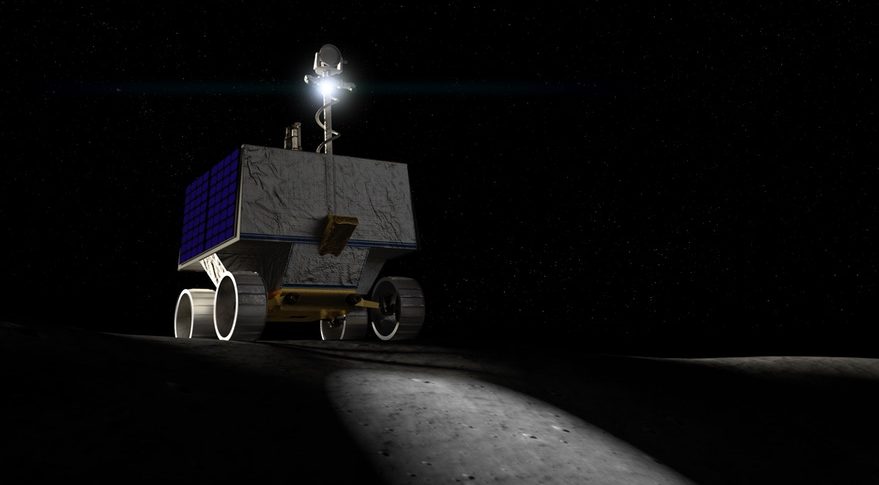Lunar water discovery may have limited effect on NASA exploration plans
Lunar water discovery may have limited effect on NASA exploration plans

WASHINGTON — Water ice may be more prevalent on the surface of the moon that previously thought, but that discovery appears unlikely to have any near-term effect on NASA’s lunar exploration plans.
In a paper published in the journal Nature Astronomy Oct. 26, scientists reported detecting traces of water in the crater Clavius on the near side of the moon using NASA’s Stratospheric Observatory for Infrared Astronomy (SOFIA) aircraft. SOFIA detected an infrared emission feature at a wavelength of 6 microns consistent with water on the surface in the vicinity of the crater.
The detection is not the first time that water has been seen on the moon. Over the last quarter-century, scientists have built up evidence, primarily from spacecraft missions, that water ice exists on the moon. That included the Lunar Crater Observation and Sensing Satellite (LCROSS) mission in 2009 that detected water in a plume of material created when a Centaur upper stage impacted the south polar region of the moon.
Those previous studies, though, have focused on the polar regions, which have permanently shadowed regions that serve as “cold traps” where ice is stable for extended periods. Clavius, by contrast, has no such shadowed regions, and is in direct sunlight for the two-week lunar day.
“The expectation is that any water present on a sunlit surface of the moon would not survive the lunar day,” said Paul Hertz, director of NASA’s astrophysics division, in a call with reporters. “This discovery reveals that water might be distributed across the lunar surface and not be limited to the cold shadowed places near the lunar poles.”
Scientists involved in the discovery don’t know for certain how the water got there. “It could be either from the solar wind or micrometeorites,” said Casey Honniball of NASA’s Goddard Space Flight Center, who led the study.
It likely survives there because it is trapped in glass beads created in micrometeoroid impacts. “These glass beads are about the size of a pencil tip and protect the water from the harsh lunar environment,” she said.
The discovery has implications for both lunar science and future exploration. NASA has emphasized the importance of water ice as a means of making human exploration of the moon sustainable. That water could be a resource to both sustain astronauts and be converted into liquid hydrogen and liquid oxygen propellants for spacecraft.
With water thought to exist only at the poles, NASA has concentrated its lunar exploration activities there. The south pole of the moon remains the preferred landing site for the first Artemis crewed landing, Artemis 3, despite comments by NASA Administrator Jim Bridenstine in September that suggested he was open to landing elsewhere on the moon. He subsequently stated that the south pole is still the primary landing area.
Water elsewhere on the moon could create new opportunities for human lunar missions beyond the polar regions. One challenge, though, is the tiny amount of water available: the concentrations detected by SOFIA are the equivalent of a 355-milliliter bottle of water in a cubic meter of regolith.
The form the water is in could also make it difficult to use. “If it’s locked into glass beads, it may require more energy to extract it,” said Jacob Bleacher, chief exploration scientist in NASA’s Human Exploration and Operations Mission Directorate. “If the water is mixed up in the soil, it might be a little easier.”
NASA has a number of robotic missions intended to help identify and characterize water ice, from orbiters to payloads on commercial lunar landers to the Volatiles Investigating Polar Exploration Rover (VIPER) mission. Those, however, have been focused primarily on studying water ice at the poles.
Asked how upcoming missions could characterize the water detected in Clavius, Bleacher mentioned VIPER and other instruments and payloads planned for lunar missions. He did not elaborate, though, on any specific plans to use them to study water there.
Sarah Noble, lunar scientist at NASA Headquarters, said that NASA still plans to send VIPER to the polar regions. However, she noted the rover will study not just potential ice deposits in permanently shadowed regions but also search for water in areas in full sunlight. “We can compare all of these different types of regions in the polar environment and really get at where the water is located,” she said. “This is a perfect opportunity for VIPER to follow up on these results.”
Honniball has her own plans to follow up on the discovery. She has two hours of observing time on SOFIA, likely in the spring of 2021, for additional observations, and has submitted a proposal for up to 72 hours of SOFIA time. “We would like to map the entire near side and also look at these volcanic features and central peaks that we think might be concentrating water,” she said.
That assumes SOFIA remains in operation. NASA did not mention in its announcement about the discovery that the agency proposed terminating SOFIA in its fiscal year 2021 budget request, arguing its scientific output did not justify its high operating costs. A House spending bill passed in July rejected that proposal and funded SOFIA, while the Senate has yet to release its version of a spending bill.
A second paper published in Nature Astronomy Oct. 26 also addressed water ice on the moon. The study found that water ice could be stable in much smaller cold traps at the lunar poles than previously thought, which could mean water could be more abundant there.
“If we’re right, water is going to be more accessible for drinking water, for rocket fuel, everything that NASA needs water for,” said Paul Hayne, an assistant professor at the University of Colorado who led the study, in a statement.
Comments
Post a Comment